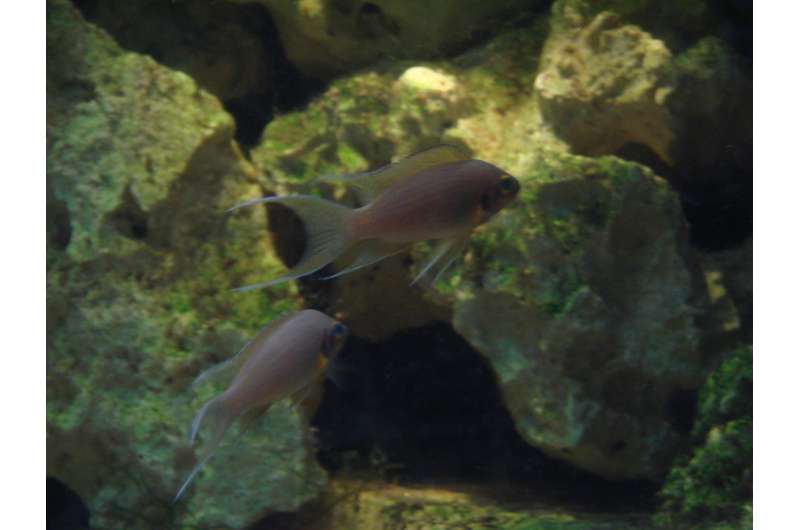February 2, 2017 report
Fish found to communicate with one another using urine

(Phys.org)—A trio of researchers with the University of Bern in Switzerland has found that at least one species of fish communicates with others of its kind using chemicals in its urine. In their paper published in the journal Behavioral Ecology and Sociobiology, the team outlines experiments they conducted with a cichlid fish and what they discovered.
Prior research has shown that some species of animals use urine as a means to communicate with one another. In this new effort, the researchers sought to learn if fish might also do so, because it seemed logical—they are not able to speak and could easily transmit chemicals through water via urine.
To find out, they inserted a partition in the middle of a fish tank that prevented fish on either side from interacting physically with one another. In some scenarios, the barrier had tiny holes to allow water to pass between the sides, while in others it did not. Also, some barriers were opaque and others were transparent. In addition, the researchers injected the fish with a blue dye that allowed them to see and measure urine being expelled by the fish once in the tank.
The researchers measured how much urine was expelled under a variety of situations—in which only one fish was in the tank; in which there were two but they could not see each other; in which there were two and they could see each other but were or were not able to communicate via urine through the barrier—the team also used a variety of fish sizes and noted fish behavior throughout each test.
The researchers looked at their results and noted that when two fish saw one another in the tank, they raised their fins and approached each other in an aggressive manner, and both emitted more urine than when they were not able to see another fish. Also, they found that only when the urine was allowed to move through the barrier was there a noticeable change in behavior of the fish—in such cases, the smaller fish generally reduced its aggressiveness, yielding to the larger one. Interestingly, the researchers also noted that when the urine was not able to pass through the barrier and the fish were able to see one another, both emitted more urine than in any other scenario, apparently aware that their message was not getting through.
More information: Dario-Marcos Bayani et al. To pee or not to pee: urine signals mediate aggressive interactions in the cooperatively breeding cichlid Neolamprologus pulcher, Behavioral Ecology and Sociobiology (2017). DOI: 10.1007/s00265-016-2260-6
Abstract
The communication of aggressive propensity is an important component of agonistic interactions. For this purpose, animals use different sensory modalities involving visual, acoustical and chemical cues. While visual and acoustic communication used in aggressive encounters has been studied extensively in a wide range of taxa, the role of chemical communication received less attention. Here, we studied the role of chemical cues used during agonistic interactions of territory owners in the cooperative cichlid Neolamprologus pulcher. During staged encounters, we allowed either visual and chemical contact between two contestants or visual contact only. As chemical information in this species is most likely transferred via urine, we measured urination patterns using dye injections. Furthermore, we recorded aggressive and submissive behaviours of both contestants in response to the experimental treatment. Fish that had only visual contact with each other significantly increased their urination frequency and showed more aggressive displays compared to fish with both visual and chemical contact. Furthermore, appropriate agonistic responses appear to be dependent on available chemical information. This indicates that N. pulcher actively emits chemical signals to communicate their aggressive propensity via urine. Chemical communication thus plays a crucial role in multimodal communication of aggression in these fish, which highlights the need of studying the role of chemical communication during agonistic encounters in general, even if other signals are more obvious to the human observer.
Journal information: Behavioral Ecology and Sociobiology
© 2017 Phys.org


















